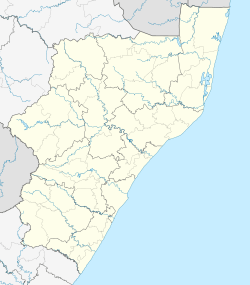Pomeroy, KwaZulu-Natal
| Pomeroy | |
|---|---|
 Pomeroy  Pomeroy Pomeroy (South Africa)  Pomeroy Pomeroy (Africa) | |
| Coordinates: 28°33′52″S 30°26′19″E / 28.56444°S 30.43861°ECoordinates: 28°33′52″S 30°26′19″E / 28.56444°S 30.43861°E | |
| Country | South Africa |
| Province | KwaZulu-Natal |
| District | Umzinyathi |
| Municipality | Msinga |
| Established | 1867 |
| Area[1] | |
| • Total | 5.97 km2 (2.31 sq mi) |
| Population (2011)[1] | |
| • Total | 1,621 |
| • Density | 270/km2 (700/sq mi) |
| Racial makeup (2011)[1] | |
| • Black African | 91.5% |
| • Coloured | 2.3% |
| • Indian/Asian | 4.3% |
| • White | 0.4% |
| • Other | 1.5% |
| First languages (2011)[1] | |
| • Zulu | 89.7% |
| • English | 6.9% |
| • Other | 3.3% |
| Time zone | UTC+2 (SAST) |
| Postal code (street) | 3020 |
| PO box | 3020 |
| Area code | 034 |
Pomeroy a small town in KwaZulu-Natal, South Africa.
Town some 72 km north of Greytown and 56 km south-south-east of Dundee. The town was named Pomeroy after Sir George Pomeroy Colley who led the ill-fated British force during the Battle of Majuba Hill in 1881.[2]
It was established as the Gordon Memorial Mission in 1867 in memory of James Henry Hamilton-Gordon, the son of George Hamilton-Gordon, 5th Earl of Aberdeen. The mission worked with the Zulus.
Pomeroy was further developed by the Boodhoo family, first 2 stores by late Mr Boodhoo who was succeeded by Herman Boodhoo who further established a Toy Manufacturing shop & first supermarkets, Boodhoo Bros and Boodhoo & Sons, was then succeeded by Puren Boodhoo who was a strong political figure, business man farmer and sportsman, Golf and Tennis, supporting & hosting the local community sports. Was then succeeded by Rambally Boodhoo who also furthered the business which strongly supporting the town growth also a strong sportsman in Golf & Tennis, Captain of the Tennis team. He was succeeded by Dan Boodhoo who was a great entrepreneur. The town is still held together by the supermarket's and stores built by the great Boodhoo Dynasty.
References
- 1 2 3 4 "Main Place Pomeroy". Census 2011.
- ↑ "Dictionary of Southern African Place Names (Public Domain)". Human Science Research Council. p. 370.
.svg.png)